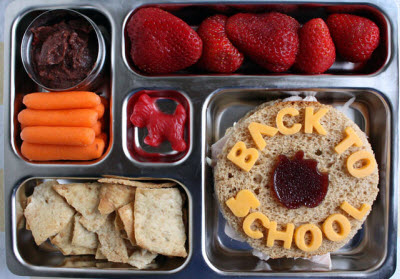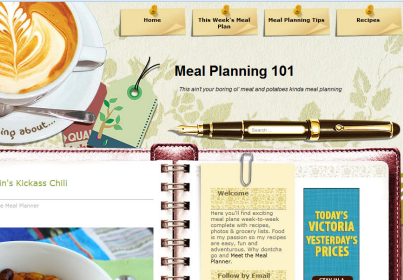 The return to school means a new round of schedules, homework and hassles; but worse for some is the return to the grind of making school lunches every day. Although a seemingly innocuous task, making lunches that kids will actually eat ranks near the top of the list of daily drudgery for many of us, up there with doing the dishes and laundry.
The return to school means a new round of schedules, homework and hassles; but worse for some is the return to the grind of making school lunches every day. Although a seemingly innocuous task, making lunches that kids will actually eat ranks near the top of the list of daily drudgery for many of us, up there with doing the dishes and laundry.
But there is hope. Although you might not ever love making lunches, here are ten tips and tricks for making school lunches more enjoyable for you to prepare and for your kids to eat.
Kids enjoy food that is cute, pretty, colorful, and fun. If it’s in a shape or cool container, they are more likely to try it. This doesn’t mean giving into packaged food. It just requires some creativity and deeper thought than slapping together a sandwich.
Luckily, the Internet is awash with fabulous ideas. Check out Wendolonia for tips on making bento box lunches (see example at left), or Funky Lunch for a gallery of sandwich characters, and of course there’s Pinterest for a bottomless well of inspiration. Maybe all you can manage is to use a cookie cutter to cut a heart- or flower-shaped sandwich every morning. That’s fine. The point is to try a new idea every week or so to keep the lunches fresh for you and your kid.
>Tip 2: Make what your kids like
(Photo credit: Wendy Copley, Wendolonia blog.)
 2. Make what your kids like
2. Make what your kids like
It sounds obvious, but start by making a list of what your kid likes to eat (not a list of what you want/wish they would eat). Lunch is not a great time to introduce new foods or engage in food battles. Be realistic. If your kid won’t touch vegetables, then don’t pack them. Talk to your kid and try to get some sense of what he/she likes.
Take note of what they enjoy eating and think about how to combine those items with other things. For example, if your kid loves fruit, maybe they might enjoy cottage cheese with fruit or a fruit and cheese kebab. Also note what they will eat at room temperature. If they prefer warm food, then by all means get them a thermos and send them to school with warm soup.
>Tip 3: Make a realistic meal plan
I’m a former project manager and even I have a hard time with this. But it does work. Sit down before you shop for food and make a meal plan for the week or month, including school lunches. Include the kids. Give them a list of choices for the fruit/vegetable component and the starch component, and a couple of choices of fillings for their wrap, sushi, or sandwich.
With school-age kids, look at the school lunch menu and decide which days they would prefer to eat the school lunch.
Also, plan dinners that will yield lunches. For example, leftover stir-fry, lasagna, meat loaf, or roasted chicken can all transform into healthy lunches the next day. If you need help with meal planning you can get free advice on the Web (e.g., Meal Planning 101), use a smartphone app like Allrecipes.com’s Dinner Spinner, or subscribe at low cost to have meal plans sent to you (e.g., RelishRelish).
Finally, be honest about your time/energy. If you have little time to cook or prepare food and/or don’t enjoy cooking, then make a list of prepared foods you can easily buy at Trader Joe’s or the like. Try to pick the healthiest options with the least amount of packaging (e.g., precut broccoli crowns, shelled edamame, hummus). You shouldn’t feel like a failure because you don’t carve your child’s veggies into Pokemon characters. I’m not particularly artistic myself, so have concentrated my time on making sure my daughter has a lot of variety and the occasional surprise in her lunch.
 4. Include your kids
4. Include your kids
It’s messier, slower, and sometimes annoying, but take the time to teach your kids how to make his/her lunch or make it with them. If they are part of the process, kids are more likely to eat their lunch. Invest in a child-friendly knife to settle your nerves and preserve their digits and a set of child-size cooking utensils. Likewise, take the kids with you to the farmers market and supermarket.
Let them pick out their lunchbox. I tried to foist my old, red plaid lunchbox on my kid but she wasn’t having it. Luckily there are lots of choices out there. You can search on Amazon or better yet, take your kids to stores like Top Ten Toys, Land of Nod, Kid’s Club, or Daiso so they can pick it out in person. We ended up with a zebra lunch bag from Skip Hop, which is great, though a bit snug with the water bottle in it. Older kids might like locally produced Dabbawalla Bags or Laptop Lunches.
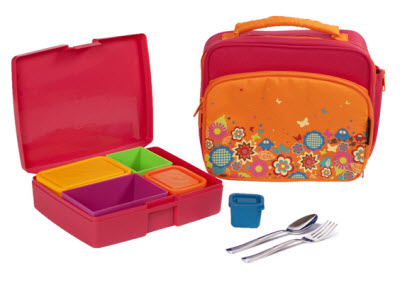 5. Re-use containers and utensils
5. Re-use containers and utensils
This is an easy way to make school lunches more eco-friendly and cost-effective, and an opportunity to up the fun factor and personalize your kid’s lunch. Storables, Container Store, and Ikea sell inexpensive sets of lidded plastic containers, which are great for sandwiches and snacks.
Get a set of leak-proof containers for liquids as well, and make sure all containers are BPA-free, dishwasher-safe, and fit in your child’s beloved lunch box. Bento box supplies are popular for school lunches for a good reason. They are cute, practical, cheap, and fun (see article "20 Bento lunches"). Goodbyn sells cool containers, as does Daiso and Uwaijimaya. Use a Sharpie to write your child’s name on the containers.
Use reusable utensils, napkins, and water bottles, too. Use groovy sporks, which provide three-utensils-in-one, or cute themed utensils. Klean Kanteen makes colorful BPA-free water bottles and thermoses. Some parents like to use reusable bags for snacks and sandwiches, but I think containers are better at protecting the contents. Cloth napkins are easily purchased at Goodwill or you can make some with fun fabrics.
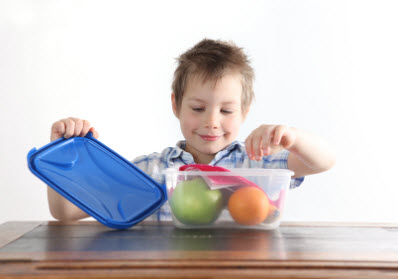 6. Keep it safe
6. Keep it safe
Include a small ice pack in the lunch box to keep the contents fresh. Most lunch boxes have a specific slot for the ice pack. You can also freeze a juice box and use that to keep the lunch cool. (In general, I’m not pro juice box. They contain a lot of sugar and kids seem to drink a few sips and then throw them away, which wastes packaging and money.)
You also might consider a thermos dedicated to 100% fruit juice if your kid can’t live without it.
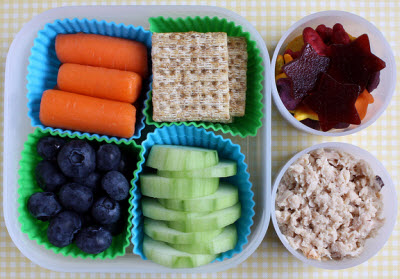 7. Adjust portion size
7. Adjust portion size
Start small. In preschool and kindergarten, the kids have a mid-morning snack so do not need a huge lunch. In grade school, they don’t have much time to eat and are eager to go play with their friends, so large lunches are mostly wasted. Many kids seem to want a quick lunch at school and then a substantial snack at home after school, so plan accordingly. They will probably tell you if they need more, but will simply throw excess food away.
(Photo credit: Wendy Copley, Wendolonia blog.)
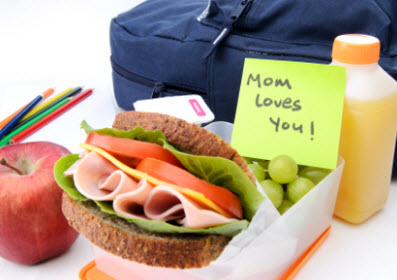 8. Add a treat or other surprise
8. Add a treat or other surprise
Sweets in small doses are a nice way to make a lunch special. Include a maple-syrup-sweetened cookie that you make at home or a chunk of high-quality chocolate, dried cranberries, or chocolate chips. Try tucking a note into the lunch. For older kids who can read, finding a personal note from a parent in their lunch can make their day.
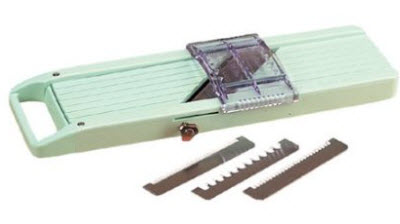 9. Get a mandoline
9. Get a mandoline
No household object has made preparing food more efficient in our home than a good mandoline (I recommend the Benriner). It makes it much easier to prep vegetables and, as we know, prettier, thinner vegetables are more palatable to kids. Consider investing in a Kevlar glove, though, as mandolines are notoriously dangerous.
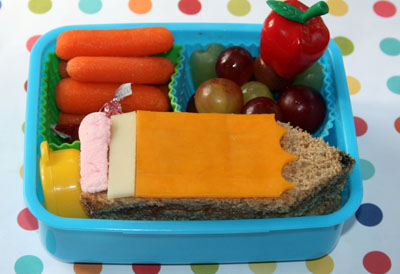 10. Experiment with different foods
10. Experiment with different foods
Here are some quick ideas for foods that can make your kid’s lunch more appealing and healthy:
Baked chicken. Few foods are as versatile and well liked as chicken. Bake a bunch of chicken breasts on Sunday night and you’ll have chicken to use in wraps, pasta salads, sandwiches, and salads for the week. A simple preparation method is to coat chicken breasts in olive oil; add salt and pepper, lemon/vinegar, and perhaps some herbs; and then bake them in a dish at 375 degrees F for 30 to 40 minutes.
Cheese. Try out different types of cheese with your kid at the supermarket cheese counter. What your kid likes might surprise you. My preschooler nearly took my hand off when I offered her a second piece of aged Gouda. Single serving cheeses like La Vache Qui Rit or Babybel are not only cute but keep well in a lunch. You can also try cutting cheese into interesting shapes. When in high-end markets like Whole Foods, check out the basket of odd-shaped end pieces of cheese that are less expensive and small. This is another way to try new cheese without going broke.
Tofu. Like chicken, tofu is very versatile. Bake a ton of it at one time and season it with different dressings/sauces and then include it in a lunch as you would any meat. Here’s the PCC Guide to Tofu and a simple method for baking tofu.
Leftover meat from dinner. You’re already firing up the grill or oven, so just make more of the main course meat. Flank steak, for example, makes great sandwiches or a nice addition to a soba salad for lunch.
Cream cheese. This wonderful substance is your friend. It binds ingredients together, keeps wraps wrapped, and adds protein and the creaminess that kids crave.
Tea sandwiches. These mini-sandwiches are crustless, fun to eat, small, and can add a lot of variety to a lunch. My daughter calls them “dainties.” Here are some filling ideas.
Pasta salads. Pasta comes in so many shapes and sizes and can combine with so many other ingredients. It’s also a great way to introduce new foods in small doses. A kid who only eats pasta might try it with bits of roasted veggies, olives, and cheese in it. Just make sure you rinse the al dente pasta with cold water after boiling it so it stays firm.
Pancakes/waffles. If your kid loves these breakfast staples, make a double batch next time and use them for lunches. Cut them into strips if the child prefers, and include a separate container of maple syrup or jam for dipping.
Omelet. If your kid loves eggs, make their favorite omelet and cut it into strips. Include some ketchup or mild salsa for dipping.
Cooked sausage. Some kids don’t mind their sausages at room temperature. Cut sausage into bite-sized pieces and add a cute cocktail fork and dip.
Sushi rolls. Sushi is another way to make lunch cute and fun, though it does require a bit more work. You can put anything in a sushi roll; we use smoked salmon and/or avocado in ours. Cucumber and omelet are other kid favorites. Here’s how to make sushi if you are a novice. If you have an older child, consider taking a sushi-making class with him/her.
Bread alternatives. Get out of the sandwich rut and put the sandwich fixings and condiments in separate containers and include a spreader, mini rice cakes, pita pockets, and/or interesting crackers.
Hard-boiled eggs. Pre-shell the eggs and include a cute salt shaker. Older kids might enjoy a dip made of mayo and mild mustard.
Cocktail forkables. Cute forks can make a meal. Add anything that is easily forked to the lunch, such as smoked salmon, meatballs, cheese or melon cubes, olives, grapes, and the list goes on. Our daughter uses antique strawberry forks and crab forks to eat all kinds of things.
Bean dips. For non-meat proteins, try different bean dips, such as black bean, lentil and walnut, or hummus. Include toppings like grated cheese in a separate container.
Skewer the food. Many bloggers are excited about presenting food on skewers for their kids (with the tip removed of course). I haven’t tried it but it looks fun, though it seems like an invitation for kids to fight with sticks.
Sesame noodles. Some of the pickiest kids will happily eat sesame noodles. You can use thin spaghetti or soba noodles. Add shredded veggies on the side or mixed in depending on whether or not your kid is a mixer. The recipe in Feeding the Whole Family by Cynthia Lair is always a winner.
Yogurt. This perennial favorite is hard to beat for its treat-like, creamy, protein combo. It’s messy of course and if it’s in a container, keep in mind that they are often hard to open, so decant the yogurt into a cute non-spill container and include a spoon.
More articles and resources
The Lunch Bunch: Packing an A+ Meal for Kids
20 Great Lunch Box Ideas for Kids.
Your Kid's Health: School Lunches and Nutrition
Here also is a helpful list of fruits and vegetables ranked by level of pesticide residue.
Photo credit on this page: Bentology
Elise Gruber is a former software project manager and SAHM who thought she would just love making lunches for her daughter. She plans to make extra chicken in September.



